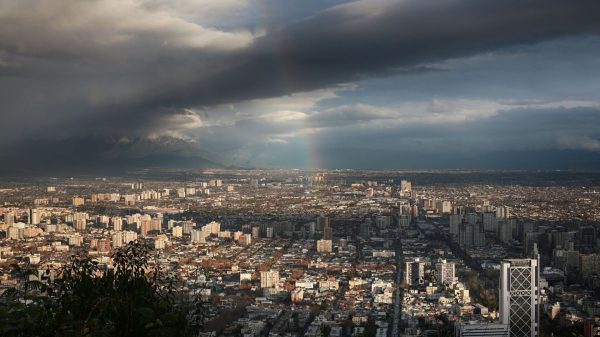The Making of a Fresco Showing the Building of a City has occupied an entire wall at the San Francisco Art Institute since Diego Rivera painted it there in 1931. A remarkable depiction of labor power in San Francisco’s industrial heyday, it is valued at roughly $50m – an enticing windfall for a school in serious jeopardy.
SFAI trustees have floated the idea of selling it as a last-ditch effort to keep one of the US’s oldest art colleges open after a years-long financial crisis. (George Lucas was reportedly an interested buyer.)
Facing a sharply diminished student body, SFAI begins the spring semester with an enormous hole in its operating budget. To plug it, the trustees have publicly mulled a once unthinkable divestment of the school’s most significant cultural patrimony, the mural by the Mexican modernist.
The move immediately proved controversial. The city’s board of supervisors convened a hearing, with one supervisor calling the potential sale “heresy” and a “crime against art”. Now, the mural is being granted landmark status, joining SFAI’s campus itself. Removing it would need the assent of San Francisco powerful Historic Preservation Commission.
As an alternative, SFAI hopes to endow the mural in situ. Pam Rorke Levy, chair of of SFAI’s board of trustees, was unable to comment on specifics but said by email that the school was in talks with other institutions over its future.
A crisis of invisibility: inside San Francisco’s planned Native American cultural center
Read more
“As a non-collecting institution … several potential paths to financial stability could include endowing the mural in place … or major donor/s joining current contributors to create a well-funded endowment,” Levy wrote. “Regarding the Rivera, our first choice would be to endow the mural in place, attracting patrons or a partner organization who would create a substantial fund that would enable us to preserve, protect and present the mural to the public.”
Overlooking the city’s famed Fisherman’s Wharf, SFAI is unique in the US: a private institution of higher learning focused on pure art at the expense of more commercial degrees. You don’t matriculate at the San Francisco Art Institute to learn animation with the hope of getting a job at Pixar; you go there to be radical and make radical art.
Alumni include the film directors Spike Jonze and Kathryn Bigelow; the performance artist Karen Finley; and Kehinde Wiley, who painted the Obamas’ official White House portraits. But if SFAI’s history is illustrious, its finances have long been a mess. Amid an edifice complex, the Board of Trustees opened a 67,000-sq-ft satellite campus in a nearby former military installation, Fort Mason, in 2013, taking on millions in debt. Meanwhile, enrollment has dropped precipitously, owing as much to the perhaps questionable utility of a quarter-million-dollar art degree as to how inhospitable cities have become to young artists.
Before the budget woes of the last few years, SFAI had been known for mounting ambitious exhibitions in its Brutalist gallery spaces. In Jill Magid’s The Proposal, she turned the cremains of the celebrated Mexican architect Luis Barragán into a diamond. For the underwater still-life photography in Alejandro Almanza Pereda’s 2015 show Everything But the Kitchen Sank, curators engineered supports for a 3,000-gallon water tank that weighed 12 tons, so it wouldn’t crush the classrooms below.
That turned out to be a prescient metaphor. At just shy of $70,000 a year, SFAI’s steep tuition demonstrates how cozy radical art-making has always been with economic privilege.
As Elizabeth Travelslight, a former adjunct union president, observed in reference to the near-total inability of creative twentysomethings to find cheap studio space in San Francisco: “Having the freedom to experiment comes at a much higher price than it used to.”
SFAI is also the last independent American arts school of its kind, its peers all either affiliated with museums or folded into larger universities. In light of its grim financial outlook, this refusal to change with the times by offering more marketable programs like graphic design or architecture seems less romantic and more quixotic – outright exploitative, even.
“The challenges that SFAI is experiencing are simply a kind of concentrated version of the challenges that other schools are facing and that have forced other schools to close,” says Hesse McGraw, SFAI’s former vice-president for exhibitions and public programs. “We’re witnessing a kind of extraordinary belief in the spirit of this school and what it’s represented over time – which is a place where magic happens, where students go and discover something about their peers and the world, what it means to be an artist, and to have impact on society.”
The pandemic certainly didn’t help. After a brush with academic de-accreditation, SFAI asked the University of California to intervene, and since October its leadership has in effect been the school’s landlord. But the financial picture is far from settled, with SFAI required to repay $19.7m in debt to UC by 2026 or vacate the campus.
Many faculty members blame the trustees for this state of affairs.
‘Rich people leave, artists and queerdos return’: is San Francisco’s tech exodus real or a fantasy?
Read more
They “tried to raise the money for Fort Mason and they failed to do that – spectacularly failed”, says Art Hazelwood, a former adjunct faculty member who remains the union president. “When Covid came along, we already knew the school wasn’t going to survive. They were projecting that in March or April. They closed and reopened, and fired all of us.”
While SFAI has emphasized that it had 300 students at the beginning of the 2020-21 school year, a former faculty member shared an email with the Guardian that specified a total of a mere seven undergrads and nine graduate students. Consequently, fewer instructors are needed.
“We had 75 or so adjuncts in our unit who were teaching, and now we have four,” says Hazelwood, who was among those terminated. “They have a full-time faculty that are still employed there, around 15 people, so they’re all still being paid. And four adjuncts, to teach 16 students. That’s a great ratio for an advertisement.”
Hazelwood estimates that the school needs roughly 400 tuition-paying students to remain solvent, and that selling the Rivera mural “would only have paid for two and a half years of operation.
“This is an institution that respects art and sells its most precious cultural legacy? It’s not a solution. It’s a hole that can’t be filled,” he says.
For now, the college is pushing ahead with a new public art piece, a three-night series of video projections against the campus’s neo-Italianate tower in late January.
In the meantime, upper-tier San Francisco real estate is in freefall. Around the corner from the school’s main campus – and one block downhill from the memorably curvy stretch of Lombard Street – a six-bedroom compound that once claimed to be San Francisco’s priciest dwelling sold last year for $27m, a 40% reduction from its 2018 listing price of $45m. In photos of the home, prospective buyers could clearly see SFAI’s tower, a visual selling point for not one overvalued property, but two.























































Свежие комментарии